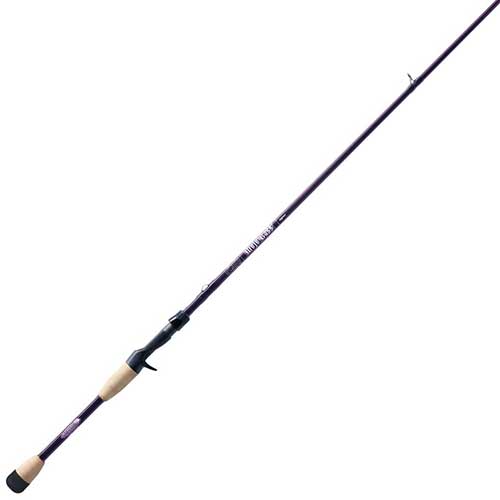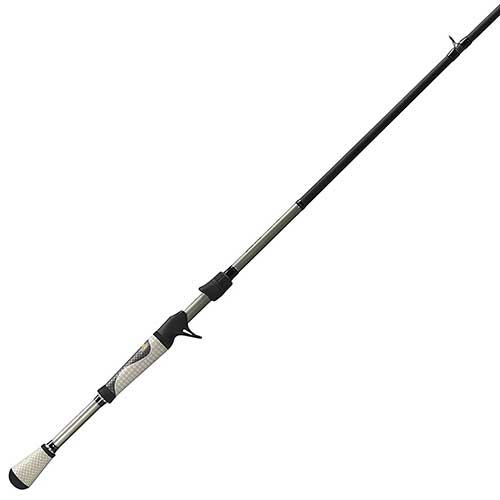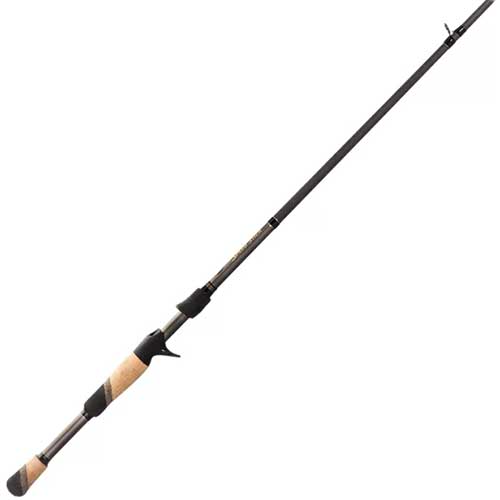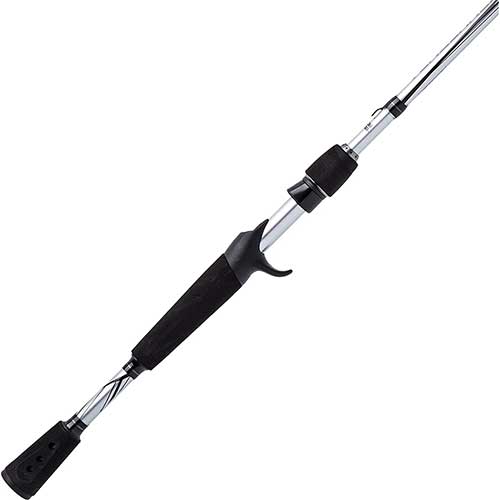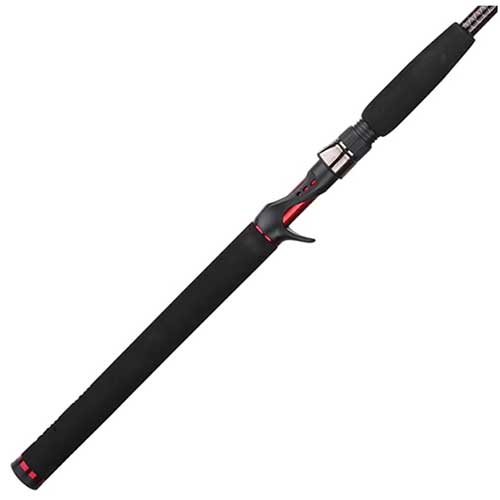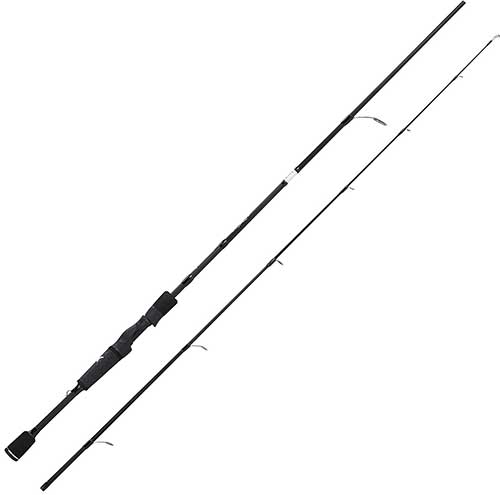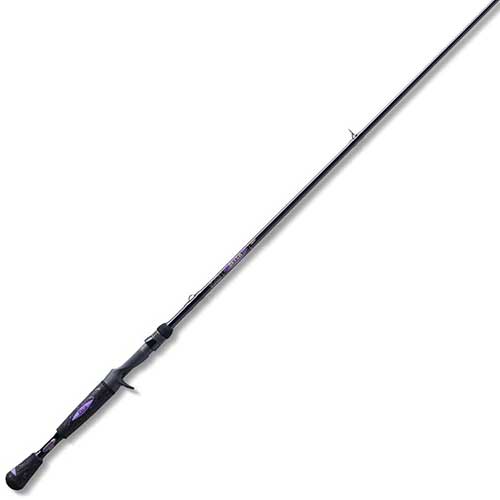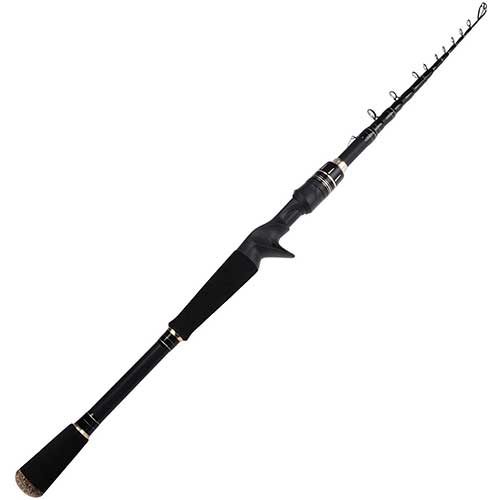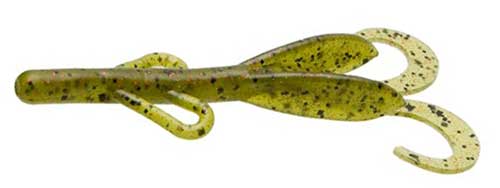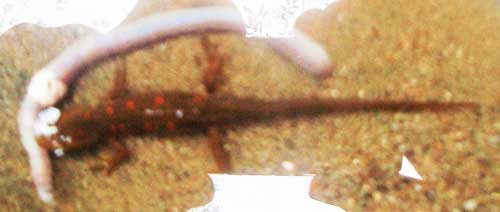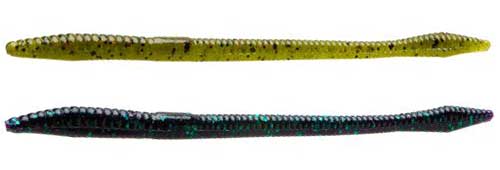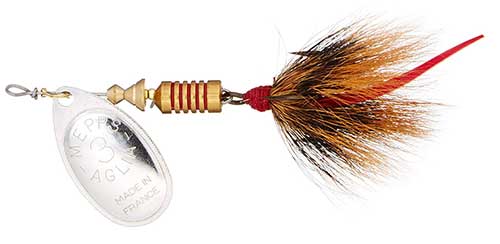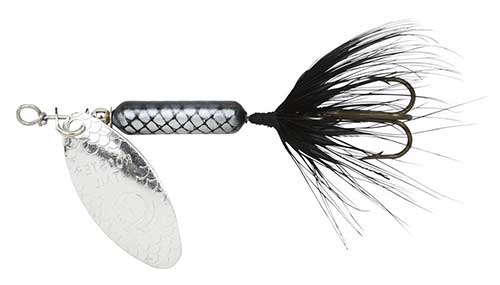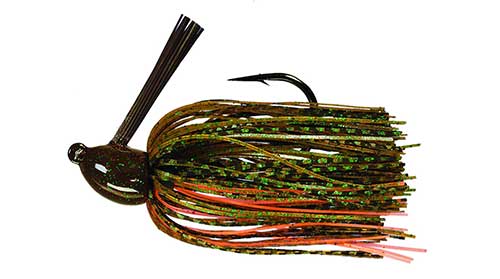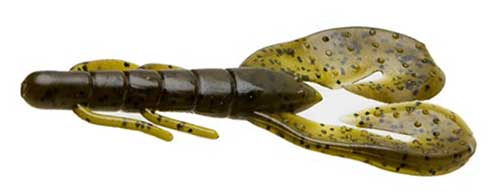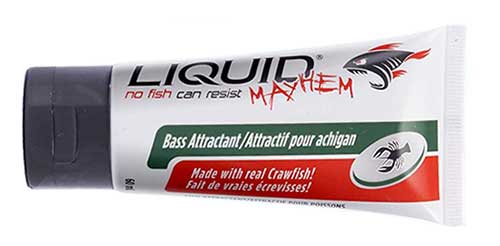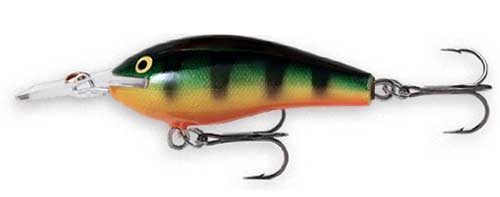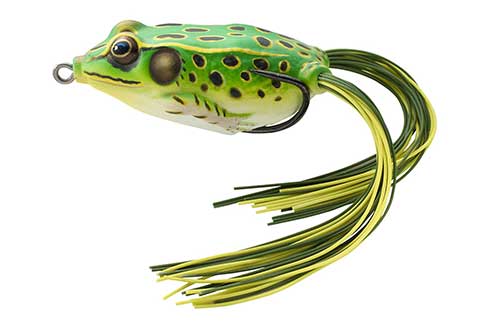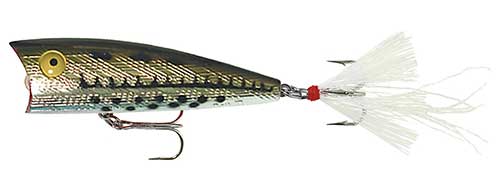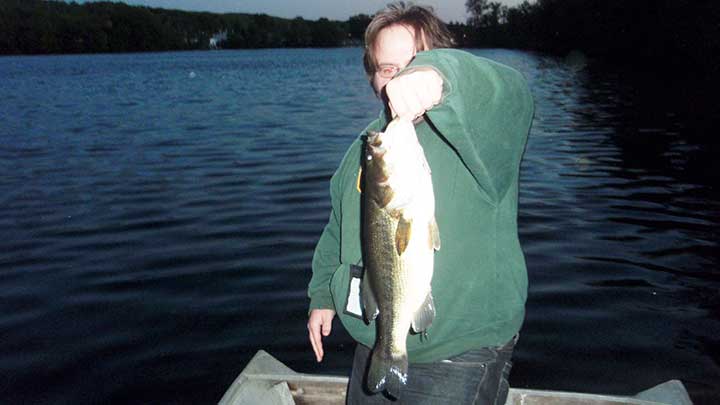Baitcasting reels provide two main advantages over spinning reels when targeting bass. First, they offer resistance to the lure during casting. This is either through internal drag mechanisms or by applying thumb pressure to the spool. This added resistance allows heavy lures and jigs to quietly splash into the water, which is a crucial factor when fishing for skittish bass in clear waters.

Second, the eyes on a baitcasting fishing pole face upward, similar to conventional fishing rods. This configuration works exceptionally well for jigging techniques that are deadly effective for bass. The baitcaster rod and reel combo allows for high torque and short vertical jigging motions to be easily applied to heavy jigs, making it perfect for working structure where big bass hide.
Bass Fishing Techniques with Baitcasting Reels
Pitching and Flipping
The precision of baitcasting reels makes them ideal for pitching and flipping techniques around structure. When bass are holding tight to cover like fallen trees, docks, or weed edges, I can accurately place my lure with minimal splash. The thumb control on a baitcaster allows me to stop the lure’s momentum exactly where I want it, often resulting in instant strikes from bass that would be spooked by the louder entry of a spinning reel cast.
Working Heavy Cover
Bass often lurk in the thickest cover available, requiring heavy line and strong hooksets to extract them. Baitcasting reels handle heavier line better than spinning reels, and the direct connection between the handle and spool provides superior power for driving hooks home through dense vegetation or woody structure. When a five-pounder burrows into a submerged brushpile, you’ll appreciate the leverage and power a properly set up baitcaster provides.
Topwater Action
For explosive topwater presentations, baitcasting reels give you precise control over walking baits, poppers, and frogs. The ability to feather the spool with your thumb lets you place these lures exactly where you want them, even under overhanging branches or in tight pockets where big bass often wait in ambush.
Selecting the Right Gear Ratio for Bass Fishing
The gear ratio of your baitcasting reel significantly impacts its performance with different bass fishing techniques. Here’s how I match gear ratios to specific applications:
- Low Gear Ratio (5.1:1 to 6.4:1): These provide more torque and are excellent for power techniques like deep cranking, big swimbaits, and heavy jigs. The slower retrieve helps keep deep diving crankbaits in the strike zone longer.
- Medium Gear Ratio (6.5:1 to 7.4:1): These versatile workhorses handle most bass fishing techniques effectively, from spinnerbaits to Texas rigs. They offer a good balance of speed and power.
- High Gear Ratio (7.5:1 and higher): Perfect for techniques requiring quick line pickup like pitching jigs, fishing topwater, or working soft plastics. When a bass strikes and immediately runs toward the boat, a high-speed reel helps you maintain tension quickly.
I have found that serious bass anglers eventually acquire reels with different gear ratios to match specific techniques. During tournaments, it’s common to see pros with 8-10 different baitcasting setups on their deck. Each reel is optimized for a particular presentation.
Types of Bass Baitcasting Reels
Standard Low-Profile Baitcasters: Versatile workhorses that balance weight, performance, and price for everyday bass fishing. These offer a comfortable palm-fitting design that reduces fatigue during long days on the water.
High-Speed Baitcasters: Feature gear ratios of 7.1:1 or higher to quickly pick up slack when pitching to cover or working fast-moving baits. Perfect for techniques requiring quick line retrieval like flipping jigs, topwater, or fishing in windy conditions.
Power Baitcasters: Built with robust gearing and lower gear ratios (5.1:1 to 6.4:1) to provide maximum torque for cranking deep-diving lures or extracting bass from heavy cover. These reels excel when using large swimbaits or pulling big bass away from structure.
Digital Control Baitcasters: Incorporate computerized braking systems that adjust spool speed thousands of times per second, virtually eliminating backlash even for beginners. These technological marvels offer unparalleled casting precision but come with a higher price tag.
Lightweight Tournament Baitcasters: Ultra-lightweight models (under 6.5 oz) designed for competitive anglers who need to reduce fatigue during long tournaments. These feature premium materials like carbon fiber and aircraft-grade aluminum to maximize strength while minimizing weight.
Durable Baitcasters: Feature sealed components and corrosion-resistant materials that withstand exposure to harsh environments, including saltwater. Ideal for bass anglers who fish brackish waters or frequently expose their gear to rain and spray.
Standard Low-Profile Baitcasters
1. Abu Garcia Revo4 SX Baitcasting Reel
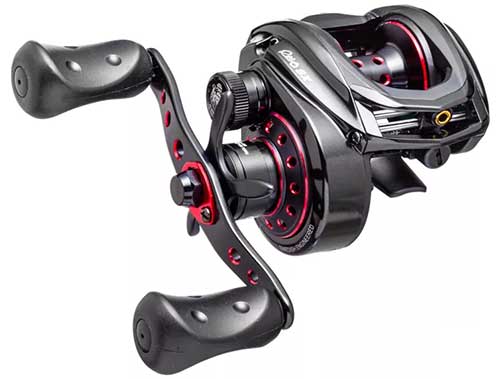
| Model 6.6:1 |
Weighs 7.8oz |
| Drag 24 Pounds | Retrieves 27 in/turn |
| Line-capacity (yd/lb) 145/12 | L-C Braid 140/30 |
| Model 7.3:1 |
Weighs 13.58 oz |
| Drag 25 Pounds | Retrieves 30 in/turn |
| Line-capacity (yd/lb) 145/12 | L-C Braid 140/30 |
The Abu Garcia Revo SX is an averaged sized high-end baitcasting reel. This reel comes in a gear ratio of 6.6 which has a typical 27 inch retrieve per turn and a 7.3 gear ratio high speed retrieve of 30 inches per turn. Both options are available in left hand models as well.
Features of this fishing reel include the X2 Craftic aluminum frame, Titanium coated line guide, infini brake system, carbon drag and 9+1 stainless steel ball bearing. This large real is great for targeting freshwater fish like largemouth bass, hybrind striped bass, northern pike, pickerel, walleye, crappie and perch.
There is also a similar Abu Garcia Revo X that weighs a little more and does not have as strong of drag. It is a lower cost reel it is a good option if strong drag is not important. Abu Garcia is a well-known brand for making baitcasting reels and convection fishing reels. This is for good reason, as they offer fantastic feature-filled reels with an attractive low profile design at a reasonable price point.
2. Abu Garcia Black Max Low Profile Baitcasting Reel
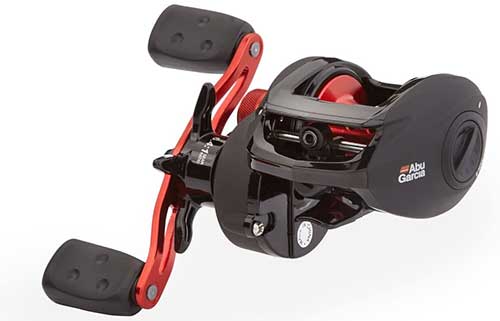
| Model Black Max |
Weighs 7.3 oz |
| Drag 18 Pounds | Retrieves 26 in/turn |
| Line-capacity (yd/lb) 145/12 | L-C Braid 140/30 |
The Abu Garcia Black Max Baitcaster comes as a right-handed or left-handed reel. It has a 6.4:1 gear ratio. Features include 5 ball bearings, an instant anti-reverse bearing, power disk drag system, and the MagTrax magnetic brake system. There is a newer version which is the Abu Garcia Max X. On the Max X the grips are red, max drag is 15 pounds, and it retrieves 25 inches of line per turn. It also holds slightly less line.
The reel is made with a one-piece graphite frame, graphite side plates, bent star drag handle, brass gear, and a red machined aluminum spool. This is a reasonably priced reel that has similar specs to high-end baitcasting reels. It has strong enough drag and holds enough line to catch large freshwater fish. This would be a great reel option for most recreational fishermen.
3. Abu Garcia Pro Max Baitcasting Fishing Reel
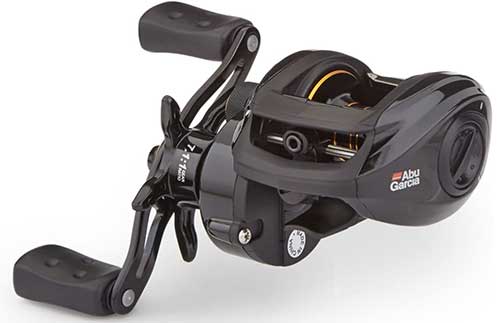
| Model 7.1 |
Weighs 7.3 oz |
| Drag 18 Pounds | Retrieves 29 in/turn |
| Line-capacity (yd/lb) 145/12 | L-C Braid 140/30 |
The Abu Garcia baitcasting reel has a 7.1: one gear ratio and comes in left-hand right-hand configurations. The c in Pmax3-c is just for plastic clam shell packaging but is the exact same reel as the Pmax3. There is also a Abu Garcia Max pro. This is the newer vestion of the reel and has a white shell and white grips.
Features of the reel include 7 Stainless steel ball bearings, an anti-reverse roller bearing, a customizable MagTrax magnetic braking system, and a power disk drag system. Pro Max reels are constructed of a single piece graphite frame with brass gears, CNC double anodized aluminum spool, and high-density EVA handles.
High-Speed Baitcasters
4. Shimano SLX Baitcasting Reels
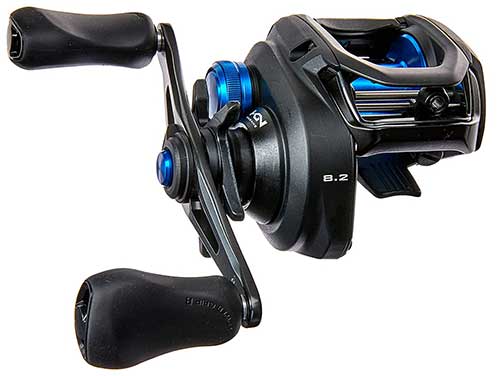
| Model 6.3 | Weighs 6.9 oz |
| Drag 12 Pounds | Retrieves 25 in/turn |
| Line-capacity (yd/lb) 110/12 | L-C Braid 150/20 |
| Model 7.2 |
Weighs 6.9 oz |
| Drag 12 Pounds | Retrieves 28 in/turn |
| Line-capacity (yd/lb) 110/12 | L-C Braid 150/20 |
| Model 8.2 |
Weighs 6.9oz |
| Drag 11 Pounds | Retrieves 32 in/turn |
| Line-capacity (yd/lb) 110/12 | L-C Braid 150/20 |
The Shimano SLX reel comes in gear ratios of 6.3:1, 7.2:1, and 8.2:1. It is also available in both right-handed and left-handed reels. Features of the reel include 3+1 ball bearings, S3D spool for a smooth lure retrieve, and super free spool for far casting due to low gear resistance on the spool.
Variable Brake Adjustment VBS is the spools brake system used to prevent bird nests when casting. The brake is centrifugal and weights are forced outward at the beginning of the cast to add a set amount of resistance that will allow for a smooth cast without backlash. The reel has a compact low profile and is constructed with a rigid Hagane metal body with a black matte finish. This is an above-average quality baitcasting reel that is good for all types and styles of bass fishing.
5. Shimano Curado K Baitcasting Reels

| Model 200K |
Weighs 7.6 oz |
| Drag 11 Pounds | Retrieves 26 in/turn |
| Line-capacity (yd/lb) 155/10 | L-C Braid 190/30 |
| Model 200HGK |
Weighs 7.6 oz |
| Drag 11 Pounds | Retrieves 31 in/turn |
| Line-capacity (yd/lb) 155/10 | L-C Braid 190/30 |
| Model 200XGK |
Weighs 7.6 oz |
| Drag 11 Pounds | Retrieves 36 in/turn |
| Line-capacity (yd/lb) 155/10 | L-C Braid 190/30 |
The Shimano Curado K series is a baitcasting reel with gear ratios of 6.2:1, 7.4:1, and 8.5:1. It has many top features for Shimano reels including cross carbon drag, X-ship gear durability, super free spool, and shielded A-RB stainless steel bearings. Other features include micromodule gear with more teeth than standard gears and the S3D spool to reduce vibration when pitching and reeling.
The SVS Infinity is a new brake system that allows smooth break control even with light lures. On the side of the reel, there is a knob that allows for precise brake adjustments. The reel is made with the Shimano Hagane metal body that is extremely rigid and durable. This a good baitcasting reel for people that only use baitcasting reels and not spinning reels. The break allows for smooth low resistance casting even with lightweight soft plastics, small poppers, and frog baits.
Power Baitcasters
6. Daiwa Tatula CT Baitcasting Reel

| Model 5.3 | Weighs 7.4 oz |
| Drag 18 Pounds | Retrieves 23.3 in/turn |
| Line-capacity (yd/lb) 120/14 | L-C Braid 130/30 |
| Model 6.3 |
Weighs 7.4 oz |
| Drag 18 Pounds | Retrieves 26.3 in/turn |
| Line-capacity (yd/lb) 120/14 | L-C Braid 130/30 |
| Model 7.3 |
Weighs 7.4 oz |
| Drag 18 Pounds | Retrieves 30.5 in/turn |
| Line-capacity (yd/lb) 120/14 | L-C Braid 130/30 |
The Daiwa Tatula CT comes in gear ratios of 5.5:1, 6.3:1 and 7.3:1. A unique feature of this baitcasting reel is the T-wing levelwind system. This allows the fishing line to exit the reel in a very wide line guide. When retrieving the line it enters the narrow section of the line guide to evenly place the line on the spool. This reduces friction during a cast.
The Magforce Z breaking system enables a low amount of resistance to the spool while still preventing backlash. This is done by lowering and raising an inductor cup within the magnetic braking system. Initially, there is minimal resistance but resistance is added once the spool is at full speed to prevent bird nests.
The reel has an aluminum frame, aluminum swept handle to reduce rod and reel wobble, soft handle knobs, aluminum spool, and aluminum tension knobs. Other features include 7+1 bearings, corrosion-resistant clutch, and oversized carbon drag washers.
Digital Control Baitcasters
7. Shimano 17 Scorpion Baitcasting Reel

| Model DC 100 |
Weighs 7.6 oz |
| Drag 11 Pounds | Retrieves 18.5-29 in/turn |
| Line-capacity (yd/lb) 110/12 | L-C Braid 110/30 |
The Shimano Scorpion baitcasting reel has a high gear ratio of 7.2:1 or 6.3:1 and is available in both left and right-handed models. This reel is constructed with a Shimano Hagane frame which is a cold forged-aluminum body.
Features include the X-SHIP ultra-high-efficiency gearing system, I-DC5 digitally controlled brake system that has 5 brake levels, and shielded ARB bearings. A smart DC brake adjusts the speed of the spool every 1/1000 of a second, essentially eliminating backlash completely. The super fee spool makes it so that casting can be done with minimal spool resistance if desired.
Lightweight Tournament Baitcaster
8. Pflueger Patriarch Low-Profile Baitcasting Reel
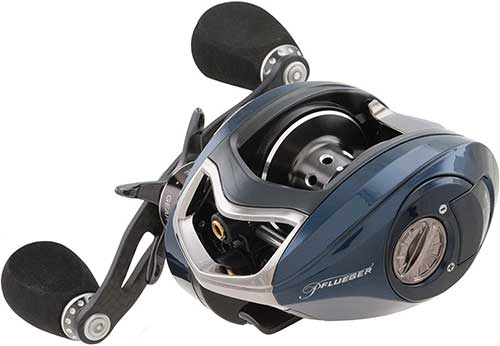
| Model 7.1 |
Weighs 6.28 oz |
| Drag 20 Pounds | Retrieves 29 in/turn |
| Line-capacity (yd/lb) 175/10 | L-C Braid 190/20 |
The Pflueger Patriarch is a low-profile baitcasting reel with a 7.1:1 gear ratio. Features include 10 stainless steel double-shielded ball bearings, a single anti-reverse bearing, Pflueger proprietary ultimate adjustable braking system, and a carbon fiber drag system.
The frame itself is machined stainless steel with C45 cam-lock carbon-infused side plates. The handle is also carbon fiber with high-grade EVA knobs that are more durable than your standard cork or rubber knobs. The shaft and gears are constructed of aircraft-grade aluminum and the drag system is comprised of more carbon fiber awesomeness. Since so many of the components are made of high-quality carbon fiber and aluminum, this reel weighs just a tad over 6 ounces. In the picture, the reel is shown as a pale blue color. In reality, this reel is actually gunmetal gray and metallic dark blue, making it a bit shinier than what the photos show.
Durable Baitcaster
8. Lew’s Inshore Saltwater Baitcasting Reel

| Model 7.5:1 | Weighs 6.6 oz |
| Drag 20 Pounds | Retrieves 30 in/turn |
| Line-capacity (yd/lb) 120/12 | L-C Braid 120/50 |
Line Choices for Bass Fishing with Baitcasters
Line selection dramatically affects your baitcasting performance when bass fishing:
- Braided Line: My personal favorite for most bass situations. It casts smoothly, has minimal stretch for solid hooksets, and its strength-to-diameter ratio lets you extract bass from heavy cover. I typically pair braid with a 4-6 foot fluorocarbon leader for improved stealth in clear water.
- Fluorocarbon: Excellent when used as main line for applications requiring invisibility and sensitivity, like fishing clear water with finesse jigs or soft plastics. It sinks naturally, which helps maintain lure depth.
- Monofilament: Still has its place, particularly for crankbaits and topwater lures where some stretch is beneficial. Its buoyancy helps keep surface lures positioned correctly.
Preventing Backlash When Bass Fishing
The dreaded backlash or “bird’s nest” is the main reason some anglers shy away from baitcasting reels. However, with proper setup and practice, you can minimize this issue:
- Spool Tension Knob: Adjust this first based on lure weight. With the brake off and spool release pressed, tighten the tension until your lure slowly descends when suspended.
- Brake System: Most modern reels feature magnetic or centrifugal braking systems. Start with higher brake settings while learning, gradually reducing as your thumb control improves.
- Thumb Control: This is the most critical skill. Keep light pressure on the spool during the cast, increasing pressure as the lure approaches its target. Always be ready to stop the spool completely when the lure hits the water.
- Practice: I recommend new baitcaster users practice in open areas before hitting the bass grounds. Cast toward specific targets at various distances until thumb control becomes second nature.
- Line Selection: Braided line is less prone to severe backlashes compared to monofilament. For beginners, starting with 30-40lb braid can make the learning curve less frustrating.
Tournament Advantages of Baitcasting Reels
There’s a reason nearly every professional bass angler relies primarily on baitcasting equipment. In competitive situations, the advantages become even more apparent:
- Speed: Quick, accurate casts mean more time with your lure in the water.
- Precision: Putting your lure exactly where a bass was spotted saves precious seconds.
- Power: When a tournament-winning fish is buried in thick vegetation, the robust construction and higher drag capabilities of a quality baitcaster can make the difference between landing and losing it.
- Versatility: From skipping jigs under docks to burning spinnerbaits over points, baitcasting reels handle the full spectrum of winning techniques.
When to Choose Spinning Reels Instead
While I’m a strong advocate for baitcasting reels in most bass fishing scenarios, I still keep spinning gear in my arsenal for specific situations:
- Ultralight lures: When bass are highly pressured or feeding on smaller forage, finesse presentations with lightweight lures under 1/8 oz often cast better on spinning equipment.
- Windy conditions: Very light finesse baits in high winds can be challenging to control with baitcasters.
- Skittish fish: In extremely clear water with spooky bass, the more subtle entry of lures cast with spinning gear sometimes produces better results.
- Beginner anglers: For those new to bass fishing, spinning gear offers a gentler learning curve while they develop fundamental techniques.
Understanding Baitcasting Reel Features for Bass
When evaluating baitcasting reels for bass fishing, several key features deserve attention:
Braking Systems
Modern baitcasting reels feature either magnetic brakes, centrifugal brakes, or both:
- Magnetic brakes use magnets to slow the spool rotation during casts. They’re easily adjustable via external dials and work consistently regardless of casting speed.
- Centrifugal brakes use internal pins that engage as the spool spins faster. They typically require opening the side plate to adjust but can provide more precise control.
- Dual-brake systems combine both technologies for the ultimate in casting control with various lure weights.
The best system depends on your fishing style and experience. When pitching to tight spots around docks or laydowns for bass, I prefer the fine control offered by a quality dual-brake system.
Frame Construction
The frame is the backbone of the reel, and material quality directly impacts performance and durability:
- Graphite frames are lightweight and corrosion-resistant, making them good options for casual bass anglers.
- Aluminum frames offer superior rigidity and strength, reducing flex during heavy hooksets and fights with larger bass.
- Carbon composite frames provide an excellent balance of lightweight performance and durability.
When I’m targeting trophy bass around heavy structure, I prioritize reels with aluminum or carbon frames that can withstand the pressure of horsing big fish from cover.
Ball Bearings
While bearing count gets much attention in marketing, bearing quality matters more than quantity:
- Shielded bearings offer some protection from water and debris.
- Sealed bearings provide the best protection and longevity, especially if you occasionally fish brackish water or expose your gear to rain and spray.
For serious bass fishing, I recommend at least 5 high-quality bearings rather than 10 low-quality ones. The difference becomes apparent after a season of hard use.
Pairing Rods with Baitcasting Reels for Bass
The right rod pairing completes your baitcasting setup. I match rod characteristics to specific bass techniques:
- Medium-heavy, fast-action rods (7′-7’6″): My workhorses for most bass applications including Texas rigs, jigs, and spinnerbaits.
- Heavy, fast-action rods (7’3″-7’6″): Perfect for fishing frogs, heavy cover techniques, and punching through matted vegetation.
- Medium, moderate-action rods (6’8″-7’2″): Ideal for crankbaits and moving baits where some “give” prevents tearing hooks loose.
- Medium-light, fast-action rods (6’10”-7’2″): Great for finesse techniques when using lighter baitcasting reels.
The right combination of rod power, action, and length dramatically impacts casting distance, accuracy, and your ability to effectively fight bass in different environments.
Maintaining Your Baitcasting Reels
Proper maintenance extends the life of your baitcasting reels and ensures reliable performance when that trophy bass strikes:
- Rinse after each use: A gentle freshwater rinse removes dirt and potential corrosive elements.
- Lubricate regularly: Apply reel oil to bearings and light grease to gears according to manufacturer recommendations.
- Check and tighten: Periodically inspect screws and components for tightness.
- Clean line guides: Buildup in the line guide can damage line and affect casting performance.
- Store properly: Keep reels in a dry environment with the drags loosened to reduce spring tension.
I’ve seen $300 reels fail after one season of neglect, while properly maintained $100 reels perform faithfully for years. The difference is almost always regular maintenance.
Common Questions About Bass Fishing with Baitcasters
How do you set the drag on a baitcasting reel for bass fishing?
Drag on all baitcasting reels is called star drag. There is a star-shaped spindle on the same side as the crank handle. Rotating the spindle counter-clockwise tightens the drag and rotating it clockwise loosens the drag. For bass fishing, I typically set the drag to about 30% of the line’s breaking strength. This gives enough pressure to drive hooks home while still allowing line to pay out when a big bass makes a sudden run.
What is the tension control knob’s role in bass fishing?
The tension control knob is a small knob usually made of aluminum on a baitcasting reel. It is not the brake but a separate tension adjustment for the reel. It applies consistent pressure to the spool rather than tension based on spool velocity. Proper adjustment will allow for far casting while also eliminating backlash and bird nests in the line. When bass fishing with lighter lures like small crankbaits, reducing tension is crucial for maximum casting distance.
What is the best line type for bass fishing with a baitcasting reel?
The best fishing line for bass fishing with a baitcasting reel is often a braided fishing line. It is lightweight which helps with far casting. Braided line is strong which can help pull bass through weeds and heavy cover. Most importantly braided line is much less likely to backlash when casting. For clearer water bass fishing, I use a 4-6 foot fluorocarbon leader when fishing with braided line to reduce visibility to the fish.
Why do bass fishing pros use baitcasting reels?
Bass fishing pros use baitcasting reels for several reasons. First, it gives them more lure control in both distance and how fast the lure enters the water. Often a quiet splash is better than a loud splash from a no-resistance cast from a spinning reel. Second, pitching jigs and bait is a quick way to place lures accurately that is not typically done with a spinning reel. Baitcasting rods have eyelets that face upward, and this configuration is more comfortable for jigging techniques commonly used in tournament bass fishing. Lastly, baitcasting reels work well with heavy lines, allowing hooks to be set firmly and big bass to be reeled in and netted quickly.
How do I stop my baitcaster from backlashing during bass fishing?
There are three controls that need to be properly set to prevent a baitcasting reel from backlashing during bass fishing. First is the tension control knob. With the brake turned off, push the button to release the spool. The lure should slowly fall due to the force of gravity. Next is the brake adjustment. Set this to higher settings for lighter bass lures and lower for heavier lures like jigs. Lastly and probably most important is your thumb. When casting always keep some pressure on the spool. Adding pressure to the spool is most important as the lure stops. If the pressure is not increased, the momentum of the spool moving forward is what causes a backlash. Once the lure has entered the water, retrieving the lure can begin.
Captain Cody has worked on charter fishing boats in the Florida Keys, Virgin Islands, and Alaska. Growing up in Pennsylvania Cody has also done extensive freshwater fishing including bass fishing tournaments. Cody strives to provide detailed information about the best fishing gear and tactics to help both novice and experienced anglers have a more productive and enjoyable time on the water. Cody also has a background in aerospace engineering and neuroscience but really only takes pride in being good at one thing and that is fishing!


